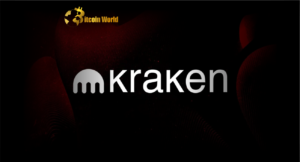- Since investors want liquidity and trust, crypto exchanges need to build trust for tokenization to grow in 2024.

In 2023, the market for tokenized business assets grew by between 16% and 23% in CAGR (compound annual growth rate).
Still, even the most optimistic valuations agree that tokenized assets currently account for less than 11% of crypto’s total valuation.
While some dubbed tokenization a failed technology, the macro trends for its adoption are finally gaining steam.
According to DeFi Llama and Fed’s research, the fraction of real-world assets in DeFi more than doubled over the last year.
The European Investment Bank now issues tokenized bonds while KKR has started to tokenize private equity fundraising.
As the regulatory environment is preparing for a merger between TradFi and blockchain, it is up to exchanges to build what no developers have been able to thus far – trust.
See Also: Base Drops From The List Of Top 10 DeFi Due To Declining TVL
Tokenization, Designed For Fractionalization And Secondary Markets
One of the original reasons for tokenized asset design was asset ownership fractionalization and the creation of secondary markets for highly illiquid assets like real estate, fine art and bonds with large face values.
The provision of additional liquidity and renewed attention from retail investors in search of portfolio diversification are long-recognized factors in the stock market, represented by the popularity of stock splits.
Overall, financial markets tend to evolve towards higher liquidity and diversification efficiency.
From overseeing and rebalancing individual stock-pick portfolios, retail investors and asset managers switched to investments in mutual funds and ETFs.
In 2022, the total volume of ETF trading in the US constituted 32.5% of the country’s equity market transactions.
Unsurprisingly, research shows that an increase in ETF ownership results in higher common liquidity measures for the underlying stock. Tokenization is the trend’s natural step forward.
With smart contracts, ownership of virtually any tokenized asset can be fractionalized and resold via shared pools.
Tokenization aligns with another trend in traditional finance – the rise of secondary markets.
Sufficiently deep secondary markets prevent investors from worrying about liquidation costs or large bid-ask spreads and provide more accurate valuation metrics and cheaper costs of raising capital.
Meanwhile, illiquid assets gravitate towards secondary markets.
For example, secondary trading of private equity funds increased fivefold from 2012 to 2022, and however controversial the role of MBS in the Global Financial Crisis may be, housing availability in the US would never reach its current state if Fannie Mae and Freddie Mac didn’t stand at the other side of the transaction.
Currently, the establishment of many secondary markets is impossible due to geographic balkanization and regulatory roadblocks.
An example of this is how foreign ownership of real estate is limited in many jurisdictions.
However, a real estate trust with tokenized claims on its balance sheet, traded at a centralized exchange with its KYC and AML procedures satisfying local licensing rules, would circumvent both of these design issues.
See Also: Goodnews! Ethereum (ETH) Users Can Now Stake An Entire Validator Directly From MetaMask
The Private Market Revolution
Private markets are applying increased pressure to their public counterparts.
According to BlackRock, private credit volume rose threefold from 2015 to 2023, but this pales in comparison with the private equity data.
The year 2021 was an unusually good one for global IPOs, with 3,260 offerings and a total value of $626.6 billion.
Yet, private equity closed 8,548 deals with a total valuation of $2.1 trillion.
Offering an annualized excess return of 4.1% over public market performance from 2000 to 2021, private equity’s assets under management reached $11.7 trillion in 2022 – almost four times the GDP of France.
So far, LP investment in a private equity fund is limited to UHNWIs (ultra-high-net-worth individuals) and institutional investors as the minimum investment sizes are extremely large.
Yet, almost $4.5 billion in private credit is already tokenized, yielding an APR of 9.3%, while KKR has dedicated part of its new fund to crypto.
Creating a tokenized ‘mutual fund-like’ pool would allow retail investors to tap into the private equity returns or even create an ETF for PE funds.
Centralized Exchanges Are Finally Getting Repo
The year 2023 saw a boom in centralized exchange crypto lending. With tokenization, the exchanges are getting safe collateral in the form of tokenized treasuries.
Just as repurchase agreements helped fuel the immense growth of the financial system from the 1990s, providing $3 trillion in daily liquidity to US banks alone, low haircuts will smooth out the crypto lending process.
Imagine pledging Bitcoin to invest in tokenized futures on Argentinian grain. This is the ultimate bridge between digital assets and real-world assets.
Investors Want Liquidity And Trust
With all the benefits of tokenization, market capitalization is fairly limited.
Limited precedent regarding technology use cases is the cause, as is its shallow secondary market liquidity.
It is unclear how to establish cross-jurisdictional contractual claims on underlying assets between thousands of investors and sellers.
Yet, centralized exchanges can do both.
In order to instill confidence from institutional and retail investors, exchanges need to maintain liquidity and trust in the tokenization system, either acting as broker-dealers with liquidity provision – like in the case of American auction-grade municipal bonds – or establishing a system of central custody like the tri-party repo.
With ISDA currently in progress on its recommendations on digital assets contracts, the necessary tools will soon be available.
Crypto has earned a reputation for disrupting the traditional financial industry but it often fails to learn from off-chain market design solutions.
Decentralized technology can work miracles, but it fails to instill trust. It is up to centralized exchanges to step up and bridge the gap.
Coinbase: Buying Cryptocurrency Is Like Collecting ‘Beanie Babies’
- SEO Powered Content & PR Distribution. Get Amplified Today.
- PlatoData.Network Vertical Generative Ai. Empower Yourself. Access Here.
- PlatoAiStream. Web3 Intelligence. Knowledge Amplified. Access Here.
- PlatoESG. Carbon, CleanTech, Energy, Environment, Solar, Waste Management. Access Here.
- PlatoHealth. Biotech and Clinical Trials Intelligence. Access Here.
- Source: https://bitcoinworld.co.in/exchanges-need-to-build-trust-for-tokenization-to-grow-in-2024/
- :has
- :is
- $3
- $UP
- 1
- 10
- 19
- 2000
- 2012
- 2015
- 2021
- 2022
- 2023
- 2024
- 32
- 7
- 8
- 9
- a
- Able
- About
- accurate
- acting
- Additional
- Adoption
- agreements
- Aligns
- All
- allow
- almost
- alone
- already
- also
- American
- AML
- an
- analysis
- and
- annual
- annualized
- Another
- any
- Applying
- apr
- ARE
- Art
- AS
- asset
- asset-managers
- Assets
- At
- attention
- availability
- available
- Balance
- Balance Sheet
- Bank
- Banks
- BCH
- BE
- been
- benefits
- between
- Billion
- Bitcoin
- Bitcoin Cash
- Bitcoin Cash (BCH)
- Bitcoin Cash (BCH) Price
- Bitcoinworld
- BlackRock
- blockchain
- Bonds
- boom
- both
- BRIDGE
- build
- build trust
- business
- but
- Buying
- by
- CAGR
- CAN
- capital
- capitalization
- case
- cases
- Cash
- Category
- Cause
- central
- centralized
- centralized exchange
- Centralized Exchanges
- cheaper
- circumvent
- claims
- closed
- CO
- Collateral
- Collecting
- Common
- comparison
- Compound
- confidence
- contracts
- contractual
- controversial
- Costs
- counterparts
- country’s
- create
- creation
- credit
- crisis
- crypto
- Crypto Exchanges
- Crypto Lending
- cryptocurrency
- Current
- Current state
- Currently
- Custody
- daily
- data
- Deals
- decision
- Declining
- dedicated
- deep
- DeFi
- DeFi llama
- delays
- Design
- designed
- developers
- digital
- Digital Assets
- directly
- diversification
- do
- does
- doubled
- Drops
- dubbed
- due
- earned
- efficiency
- either
- Entire
- Environment
- equity
- establish
- establishing
- establishment
- estate
- ETF
- ETFs
- ETH
- ethereum
- ethereum (ETH)
- European
- Even
- evolve
- example
- excess
- exchange
- Exchanges
- extremely
- Face
- factors
- Failed
- fails
- fairly
- far
- fidelity
- Finally
- finance
- financial
- financial crisis
- financial system
- fine
- Fine Art
- For
- foreign
- form
- Forward
- four
- fraction
- fractionalization
- France
- from
- Fuel
- fund
- Fundraising
- funds
- Futures
- gaining
- gap
- GDP
- geographic
- getting
- Global
- global financial
- Global Financial Crisis
- good
- grew
- Grow
- Growth
- Have
- helped
- higher
- highly
- housing
- How
- How To
- However
- HTML
- HTTPS
- if
- immense
- impossible
- in
- Increase
- increased
- individual
- individuals
- industry
- instill
- Institutional
- institutional investors
- into
- Invest
- investment
- Investments
- Investors
- IPOs
- isda
- issues
- IT
- ITS
- jpg
- jurisdictions
- kkr
- Korea’s
- KYC
- large
- Last
- Last Year
- LEARN
- lending
- less
- Licensing
- like
- Limited
- Liquidation
- Liquidity
- liquidity provision
- List
- Llama
- local
- Low
- LP
- mac
- Macro
- maintain
- management
- Managers
- many
- Market
- Market Capitalization
- market performance
- Markets
- May..
- measures
- Merger
- Metrics
- minimum
- miracles
- more
- most
- municipal
- mutual
- mutual funds
- Natural
- necessary
- Need
- never
- New
- no
- now
- of
- Offerings
- Office
- often
- on
- ONE
- Optimistic
- or
- order
- original
- Other
- out
- over
- overseeing
- ownership
- P&E
- part
- performance
- plato
- Plato Data Intelligence
- PlatoData
- pool
- Pools
- popularity
- portfolio
- portfolios
- Precedent
- preparing
- president
- pressure
- prevent
- price
- private
- Private Equity
- procedures
- process
- Progress
- provide
- providing
- provision
- public
- Public Market
- raising
- raising capital
- Rate
- reach
- reached
- real
- real estate
- real world
- reasons
- rebalancing
- recommendations
- regarding
- regulatory
- renewed
- represented
- reputation
- research
- Results
- retail
- Retail Investors
- return
- returns
- Rise
- roadblocks
- Role
- ROSE
- ROW
- rules
- safe
- saw
- Search
- secondary
- Secondary Market
- Secondary Markets
- Sellers
- shallow
- shared
- sheet
- Shows
- side
- sizes
- smart
- Smart Contracts
- smooth
- Solutions
- some
- Soon
- South
- Splits
- Spreads
- stake
- stand
- started
- State
- Steam
- Step
- stock
- stock market
- switched
- system
- TAG
- Tap
- Technology
- tend
- than
- that
- The
- their
- These
- this
- thousands
- Thus
- till
- times
- to
- Tokenization
- tokenize
- tokenized
- tokenized assets
- tools
- top
- Top 10
- Total
- towards
- traded
- TradFi
- Trading
- traditional
- traditional finance
- transaction
- Transactions
- Treasuries
- Trend
- Trends
- Trillion
- Trust
- tutorial
- ultimate
- unclear
- under
- underlying
- us
- US banks
- use
- users
- Validator
- Valuation
- Valuations
- value
- Values
- via
- virtually
- volume
- want
- was
- What
- while
- will
- with
- Work
- worrying
- would
- year
- yielding
- zephyrnet












